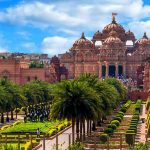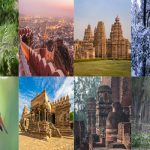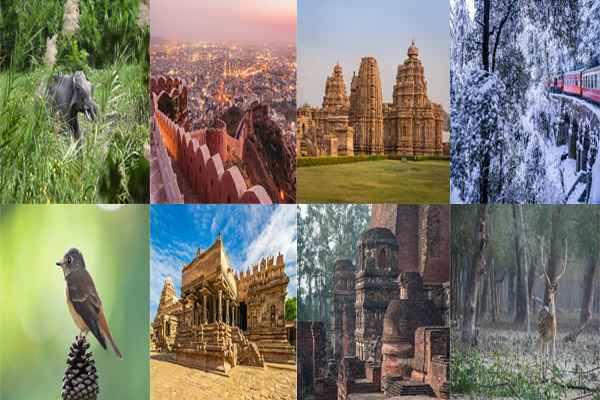India, a vast and diverse subcontinent, unfolds like a tapestry of varied landscapes, cultures, and traditions. In this exploration, we invite you to embark on a journey through the enchanting regions of North, South, East, West, and Central India, as well as the Union Territories, each offering a unique blend of history, cuisine, and natural beauty.
North India: Majestic History and Himalayan Splendor
1. States (e.g., Delhi, Uttar Pradesh, Rajasthan):
North India, home to the historic capital Delhi, showcases the architectural marvels of the Mughal era, including the iconic Taj Mahal in Agra. Rajasthan, with its vibrant culture, palaces, and desert landscapes, adds a regal touch to the region.
2. Popular Cities:
Explore the bustling streets of Delhi, witness the spiritual ambiance of Varanasi along the Ganges, and experience the royal charm of Jaipur. Each city in North India narrates a different chapter of the nation’s rich heritage.
3. Landmarks:
The region boasts landmarks like the Qutub Minar, Hawa Mahal, and the mystical Varanasi ghats. The Himalayan range in the north offers breathtaking views and a serene escape into nature.
South India: Rich Heritage and Coastal Beauty
1. States (e.g., Tamil Nadu, Karnataka, Kerala):
South India, a treasure trove of ancient temples and cultural heritage, includes the dynamic Tamil Nadu, Karnataka’s diverse landscapes, and Kerala’s lush greenery and backwaters.
2. Popular Cities:
Chennai’s modernity, Bangalore’s tech hub status, and the laid-back charm of Kochi are just glimpses of the vibrant cities that define South India’s diverse urban landscape.
3. Landmarks:
Visit the intricately carved temples of Tamil Nadu, the historic ruins of Hampi in Karnataka, and the serene backwaters of Alleppey in Kerala. Each landmark resonates with the unique cultural identity of South India.
East India: Cultural Diversity and Natural Wonders
1. States (e.g., West Bengal, Odisha, Bihar):
East India captivates with its cultural diversity. West Bengal, known for its literary heritage and Durga Puja celebrations; Odisha, with its ancient temples and beaches; and Bihar, home to Nalanda University, present a fascinating mix.
2. Popular Cities:
Kolkata’s artistic fervor, Bhubaneswar’s temple city status, and the historical richness of Patna offer a glimpse into the dynamic urban life of East India.
3. Landmarks:
From the Howrah Bridge in Kolkata to the Sun Temple in Konark, East India’s landmarks reflect a harmonious blend of history, art, and natural beauty.
West India: Vibrant Culture and Coastal Charms
1. States (e.g., Maharashtra, Gujarat, Rajasthan):
West India showcases the bustling metropolis of Mumbai, the cultural tapestry of Gujarat, and the majestic forts and palaces of Rajasthan.
2. Popular Cities:
Experience the glamour of Bollywood in Mumbai, the vibrant festivals of Ahmedabad, and the royal grandeur of Udaipur. West India’s cities are a mix of modernity and historical richness.
3. Landmarks:
Marvel at the Gateway of India in Mumbai, explore the White Rann in Gujarat, and wander through the historic forts of Rajasthan. West India’s landmarks narrate tales of valor and cultural opulence.
Central India: Historical Legacy and Natural Retreats
1. States (e.g., Madhya Pradesh, Chhattisgarh):
Central India, with its historical legacy, includes the ancient temples of Khajuraho in Madhya Pradesh and the tribal landscapes of Chhattisgarh.
2. Popular Cities:
Visit Bhopal, the city of lakes, and explore the architectural wonders of Khajuraho. Central India offers a mix of historical charm and natural beauty.
3. Landmarks:
Admire the intricate carvings of Khajuraho temples, explore the tribal culture of Chhattisgarh, and witness the wildlife wonders of Kanha National Park. Central India is a haven for history enthusiasts and nature lovers alike.
Union Territories: Microcosms of Cultural Diversity
1. (e.g., Andaman and Nicobar Islands, Chandigarh, Jammu and Kashmir):
Union Territories like the scenic Andaman and Nicobar Islands, the planned city of Chandigarh, and the serene landscapes of Jammu and Kashmir offer microcosms of cultural diversity.
2. Highlights:
From the pristine beaches of Andaman to the modern architectural marvels of Chandigarh and the picturesque valleys of Kashmir, Union Territories present unique highlights.
Embark on a journey through the regions and Union Territories of India, where each corner unfolds a unique story, a vibrant culture, and a slice of the nation’s rich heritage.

FAQs: Navigating the Diversity of India’s Regions
Q1: What makes North India culturally significant?
- A: North India is culturally significant for its historical landmarks, including the Taj Mahal and Qutub Minar, as well as its vibrant festivals like Diwali and Holi. The region showcases a rich tapestry of Mughal and Rajput influences.
Q2: How diverse are the cuisines across North India?
- A: North Indian cuisine is diverse, with each state contributing unique flavors. From the rich Mughlai dishes of Delhi to the spicy Rajasthani curries, the culinary journey in North India is a delightful exploration.
Q3: What sets South India apart in terms of cultural heritage?
- A: South India boasts a rich cultural heritage with its ancient temples, classical dance forms like Bharatanatyam, and the unique traditions associated with festivals like Pongal. The region’s architecture and artistic expressions are distinctive.
Q4: How does East India celebrate its cultural diversity?
- A: East India celebrates its cultural diversity through vibrant festivals like Durga Puja in West Bengal, the Rath Yatra in Odisha, and the Chhath Puja in Bihar. The region is also known for its literary contributions and traditional art forms.
Q5: What coastal attractions make West India a popular destination?
- A: West India is known for its coastal charms, including the beaches of Goa, the architectural wonders of Mumbai, and the serene beauty of Udaipur’s lakes. The region’s diverse landscapes cater to both history enthusiasts and nature lovers.
Q6: What historical legacies are preserved in Central India?
- A: Central India preserves historical legacies such as the ancient temples of Khajuraho and the tribal heritage of Chhattisgarh. The region’s landmarks reflect a blend of cultural richness and natural retreats.
Q7: How do Union Territories contribute to India’s cultural diversity?
- A: Union Territories like Andaman and Nicobar Islands, Chandigarh, and Jammu and Kashmir contribute to India’s cultural diversity by offering unique landscapes, architectural marvels, and regional traditions distinct from mainland states.
Q8: Which Union Territory is known for its scenic beauty and beaches?
- A: The Andaman and Nicobar Islands are renowned for their scenic beauty, pristine beaches, and diverse marine life. The archipelago is a popular destination for nature lovers and water enthusiasts.
Q9: What makes Kashmir a sought-after destination in Jammu and Kashmir?
- A: Kashmir is known for its breathtaking landscapes, including the Dal Lake, Gulmarg’s snow-capped mountains, and the vibrant Shikara rides. The region’s cultural heritage and warm hospitality also contribute to its allure.
Q10: How can travelers plan a diverse itinerary to experience the best of India’s regions?
- A: Travelers can plan a diverse itinerary by researching the cultural festivals, landmarks, and natural attractions unique to each region. Considering the geographical spread, it’s advisable to explore one or two regions at a time to fully immerse in the local experiences.
Explore the diversity of India’s regions through these FAQs, and set out on a journey that unveils the multifaceted beauty and cultural richness of this incredible nation.







